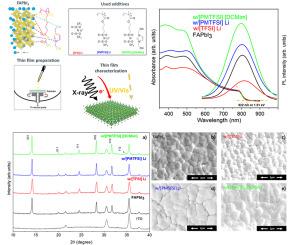Improvement of electronic structure, optical properties, and crystalline quality of FAPbI3 perovskite thin films by poly(ionic liquid) additives based on polymerized TFSI ion
IF 4.2
3区 材料科学
Q2 MATERIALS SCIENCE, MULTIDISCIPLINARY
引用次数: 0
Abstract
Over the past decade, organic-inorganic halogen perovskite solar cells (PSCs) have made significant stride toward achieving record efficiencies. However, their long-term stability under ambient conditions, largely hindered by the perovskite material itself, remains a major obstacle to large-scale production. Herein, we present two novel poly(ionic liquid)s (PILs) as promising additives to improve the quality of formammidinium lead iodide (FAPbI3) perovskite thin films. The synthesized PILs, Poly(lithium bis(trifluoromethanesulfonyl)imide) and Poly(imidazolium bis(trifluoromethanesulfonyl)imide) abbreviated as [PMTFSI] Li and [PMTFSI] [DCMim], respectively, are based on polymerized TFSI anions which have shown great potential for healing the defects in the perovskite structure. The presence of multiple functional groups in PILs structure, such as sulfonyl, carbonyl, nitrile, trifluoromethyl, N+ in imidazolium, renders the interaction with the host perovskite materials, efficiently passivating defects throughout the perovskite film. Obtained results are further compared with the results acquired for the counterpart salt lithium bis(trifluoromethanesulfonyl)imide shortly LiTFSI or [TFSI] Li. This study highlights the potential of PILs based on polymerized TFSI for the preparation of FAPbI3 thin films under ambient conditions with enhanced crystalline quality which is expected to improve both the stability and efficiency of PSCs.

基于聚合TFSI离子的聚离子液体添加剂改善FAPbI3钙钛矿薄膜的电子结构、光学性能和晶体质量
在过去的十年中,有机-无机卤素钙钛矿太阳能电池(PSCs)在实现创纪录效率方面取得了重大进展。然而,它们在环境条件下的长期稳定性,很大程度上受到钙钛矿材料本身的阻碍,仍然是大规模生产的主要障碍。在此,我们提出了两种新型的聚离子液体(pil)作为有前途的添加剂,以提高碘化甲醛铅(FAPbI3)钙钛矿薄膜的质量。合成的聚(锂二(三氟甲磺酰基)亚胺)和聚(咪唑二(三氟甲磺酰基)亚胺)分别缩写为[PMTFSI] Li和[PMTFSI] [DCMim],它们是基于聚合的TFSI阴离子,在修复钙钛矿结构缺陷方面表现出很大的潜力。PILs结构中存在多个官能团,如磺酰基、羰基、腈基、三氟甲基、咪唑中的N+等,使其与宿主钙钛矿材料相互作用,有效地钝化了整个钙钛矿薄膜中的缺陷。所得结果进一步与对应物二(三氟甲烷磺酰)亚胺锂(简称LiTFSI或[TFSI] Li)所得结果进行了比较。本研究强调了基于聚合TFSI的PSCs在环境条件下制备FAPbI3薄膜的潜力,并提高了晶体质量,有望提高PSCs的稳定性和效率。
本文章由计算机程序翻译,如有差异,请以英文原文为准。
求助全文
约1分钟内获得全文
求助全文
来源期刊

Optical Materials
工程技术-材料科学:综合
CiteScore
6.60
自引率
12.80%
发文量
1265
审稿时长
38 days
期刊介绍:
Optical Materials has an open access mirror journal Optical Materials: X, sharing the same aims and scope, editorial team, submission system and rigorous peer review.
The purpose of Optical Materials is to provide a means of communication and technology transfer between researchers who are interested in materials for potential device applications. The journal publishes original papers and review articles on the design, synthesis, characterisation and applications of optical materials.
OPTICAL MATERIALS focuses on:
• Optical Properties of Material Systems;
• The Materials Aspects of Optical Phenomena;
• The Materials Aspects of Devices and Applications.
Authors can submit separate research elements describing their data to Data in Brief and methods to Methods X.
 求助内容:
求助内容: 应助结果提醒方式:
应助结果提醒方式:


